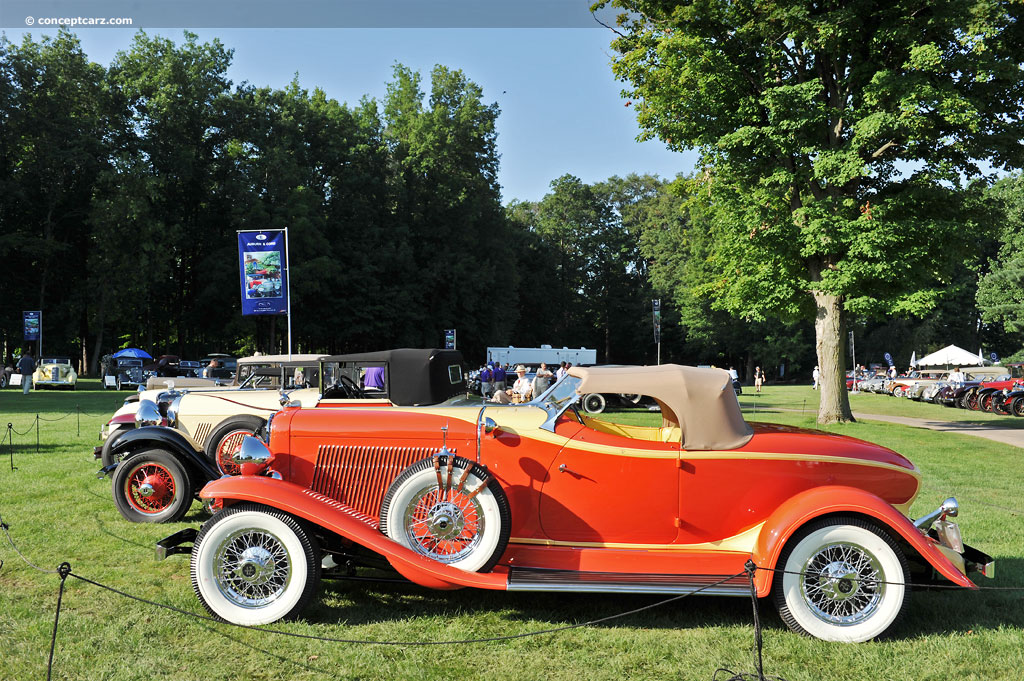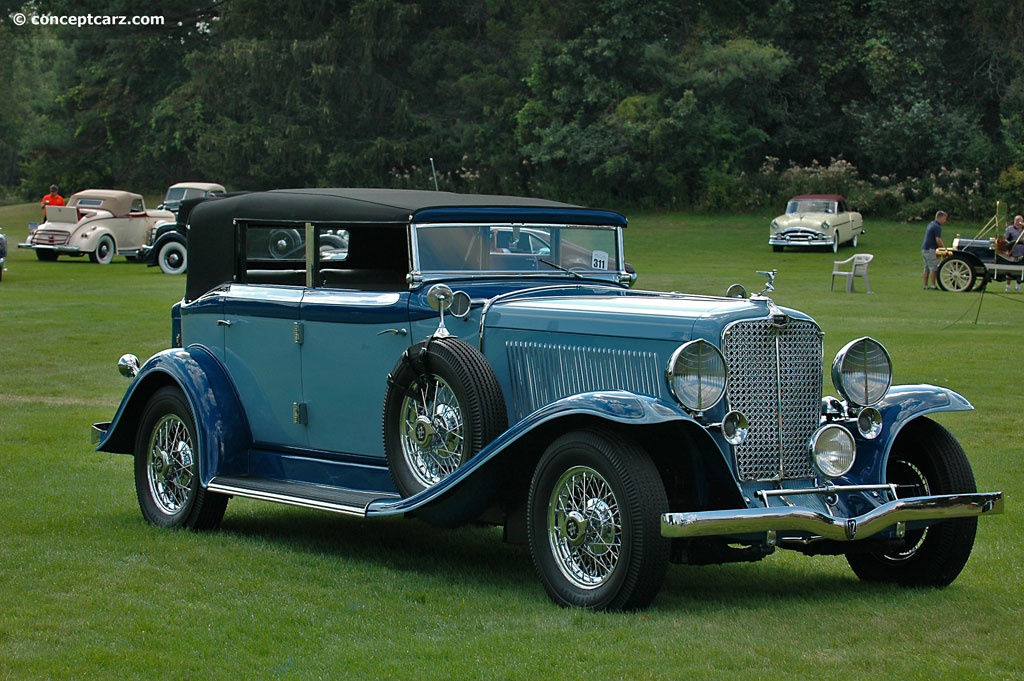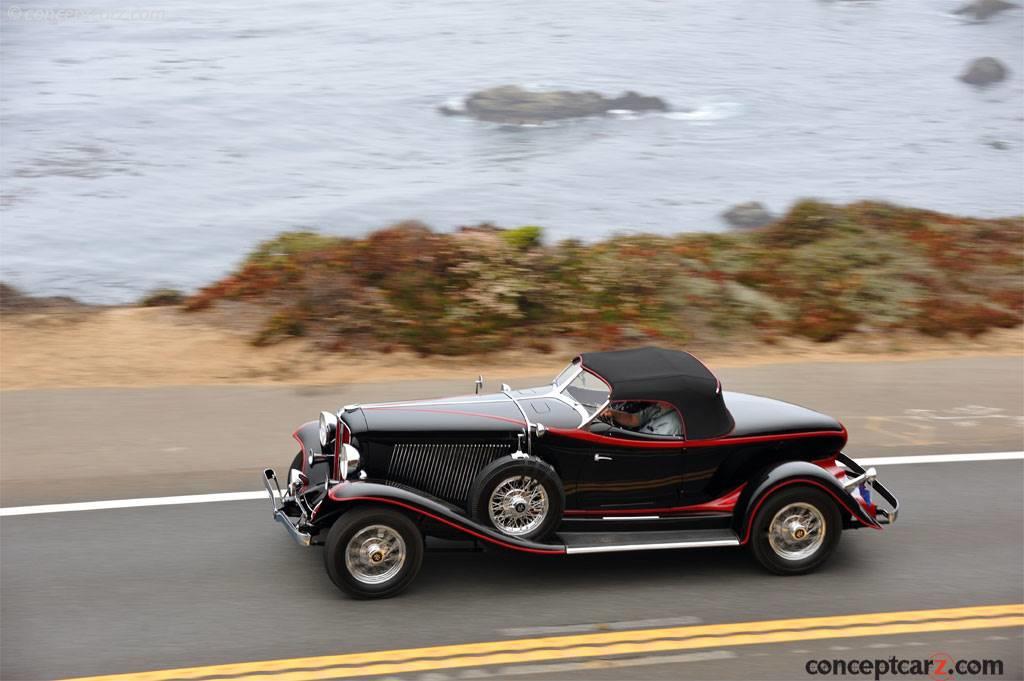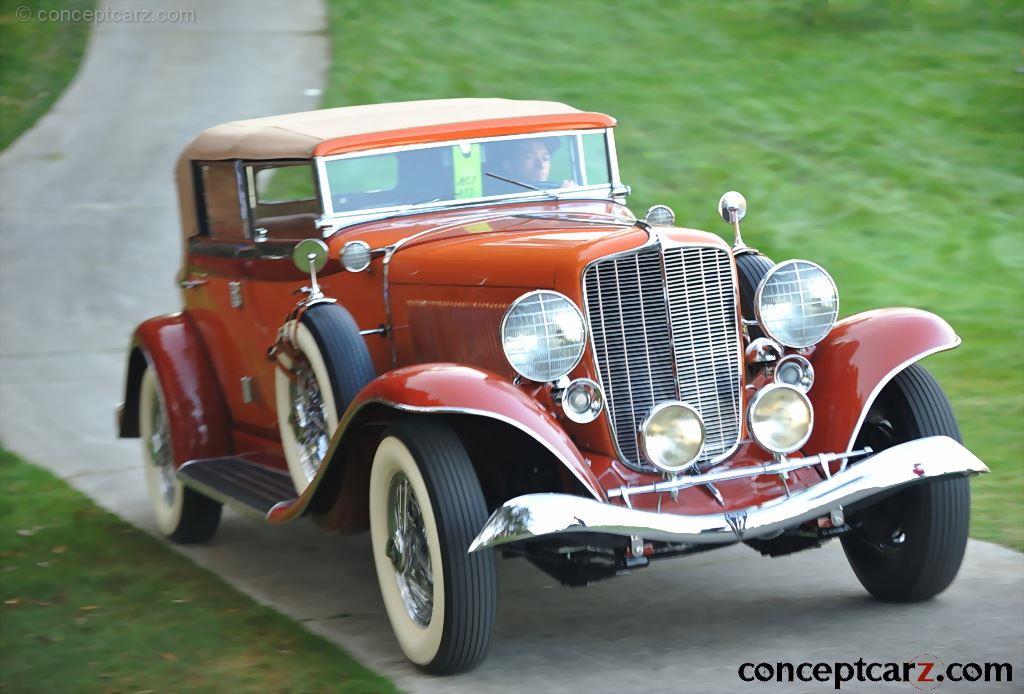The Auburn name and reputation are most associated with the speedsters of the late 1920s and 1930s, its resurrection by E.L. Cord, and its association with the Auburn Cord Duesenberg Corporation. Its legacy, however, stretches much farther back, beginning in 1900 in Indiana and producing single- and twin-cylinder models exclusively until 1909. Many enterprising individuals attempted to build motorcars, and most failed. Those that were successful often relied on good engineering and an immense amount of capital. 
Boattail Speedster
View info and history
Auction entries : 1The first of the four-cylinder Auburn models was introduced in 1909 and would become the foundation for the new models going forward. An upmarket inline six-cylinder model was introduced in 1913 and became the sole offering from 1918 through 1924. Six- and Eight-cylinder models were offered from 1925 through 1931. Only the eight-cylinder model was offered in 1931, and the following year, it was joined by a twelve-cylinder option.Errett Lobban CordThe post-World War I recession had devastating effects on the economy in the late 1910s and early 1920s, and Auburn was not immune to its effects. They produced more vehicles than they were selling, and hundreds of unsold vehicles rested in the company's parking lot when E.L. Cord visited in 1924. 
Phaeton Sedan
View info and historyThe Auburn Automobile Company had grown out of the Eckhart Carriage Company which had been founded in 1874 by Charles Eckhart. His sons, Frank and Morris, were instrumental in transitioning from Carriage building to automobile production. In 1919, the Eckhart brothers sold the Auburn company to a group of Chicago investors headed by Ralph Austin Bard. Attempts were made by the new owners to revive the business, but it remained unprofitable. In 1924, they enlisted the services of an automobile salesman named E.L. Cord to help transform the company. When Mr. Cord was offered a position to run the company, he countered with what amounted to a leveraged buyout. With an agreement in place, Mr. Cord worked aggressively to stimulate sales, having the unsold cars repainted and adding a bit of nickel plating to enhance their appeal. In 1925, Cord directed chief engineer James Crawford to install some Lycoming straight-eight engines into the six-cylinder chassis. The new color schemes and diversified product line helped Cord sell the remaining inventory and by the close of 1925, had completed his buyout. By the close of the 1920s, E.L. Cord controlled over 150 companies, mostly in the field of transportation. He founded the Cord Corporation in 1929 as a holding company for his diverse portfolio of companies, which included Duesenberg Inc, Checker Cab, Stinson Aircraft Company, American Airways, and Lycoming Engines. The rapid ascension of success was followed by a rapid decline due to the stock market crash of 1929 and Cord's illegal stock manipulations that eventually forced him to lose control of his automobile holding company. Automobile production by Auburn, Cord, and Duesenberg ended in 1937.The Great Depression and the Cylinder Wars
Phaeton Sedan
Chassis #: 1094H
View info and history
Auction entries : 1Many automobile companies during the later portion of the 1920s enjoyed tremendous success, and for Auburn, this was true. They produced 4,044 vehicles in 1925, 7,138 the following year and 14,515 in 1927. Production dipped slightly in 1928 to 12,899 units before nearly doubling to 23,509 units in 1929, then falling back to 12,985 units the following year. The cylinder wars of the early 1930s added another blow to companies in the luxury car segment, as Cadillac and Marmon both introduced sixteen-cylinder models. Although Duesenberg's eight-cylinder engine had fewer cylinders, it was the most powerful with 265 horsepower. With the optional supercharger installed, the output rose to 320 horsepower. No other manufacturer would come close to offering a production engine with this much power until Chrysler's C-300 of 1955, which had 300 horsepower. With depleted resources, shrinking sales, and increasing competition, many automakers were forced out of business. Some companies attempted to remain relevant by moving down market, while others went 'all in' by introducing new products and styling to gain a greater foothold in the luxury segment. 
Phaeton Sedan
Chassis #: 2156 H
Engine #: BB 2251B
View info and history
Auction entries : 1Auburn was in a unique position as its parent company was well-diversified, with Duesenberg at the top and the Cord automobile exploring the unexplored front-wheel-drive market segment. Auburn also enjoyed a growing number of dealerships, the resources of the Lycoming engine company, and a talented group of stylists. Though production had dipped in 1930, it rebounded in 1931 to 34,228 units - its best year of production. The euphoria was short-lived, as production fell drastically in 1933 to 11,145 units, then 5,038 in 1933, and 7,770 in 1934. The Boattail SpeedsterAuburn's record-setting success was due, in part, to the new streamlined, lightweight sports car dubbed the Speedster. It was developed from a Dusenberg design by John Tjaarda (bodied by McFarlan) by either Count Alexis de Sakhnoffsky or possibly Al Leamy. Al Leamy was a recent addition to the Auburn staff and would be given the task of designing the L-29 Cord automobile. The Speedster had a tapered, sloping tail which resulted in limited space for luggage and accommodations for two individuals. Its limited practicality was compensated by its stunning design which left no double about its purpose - for high-speed motoring. It featured swept-back hood side louvers, matching door line angles, and a steeply raked windshield. 
Boattail Speedster
View info and historyWade Morton proved that the Speedster was more than just 'show' as he set a AAA stock car record on the sands at Daytona Beach, Florida, on February 20th of 1928, driving a stock-bodied 1928 Auburn 115 Speedster at 104.347 miles per hour. The early Auburn Speedsters were raced on two continents, appealing to such European drivers as Sir Malcolm Campbell, who drove one as a road car.Eddie Miller set 31 American stock car speed records with the Speedster at Muroc Dry Lake in December of 1931 in trials observed by the AAA. Mechanical Sophistication
Phaeton Sedan
Chassis #: 12-165 1147 H
Engine #: BB 2152
View info and history
Auction entries : 2The Auburn chassis received four-wheel hydraulic brakes in 1928, making them one of the first to use this technology on a series production automobile. Braking was later improved by the fitting of a vacuum power booster which could be manually adjusted via a control on the dashboard. Four different settings were available depending on road and weather conditions. Auburn engineers helped prepare its drivers for 'dry weather', 'rain', 'snow' and 'ice' settings. A new Startix automatic starter was added in 1932 and Custom models received Delco ride regulations which were shock absorbers that were adjustable from the driver's compartment. This allowed the driver to select either a softer or firmer ride depending on the road conditions or the driver's needs. Custom models also were given a vacuum-controlled two-speed axle known as Dual Ratio. This also gave drivers the freedom of selecting a 4.54:1 or 3.00:1 gear ratio. The 3.00:1 had better economy while the 4.54 had better performance. A Salon version was added to both the 8- and 12-cylinder series in 1933. The Lycoming V12 Auburn had been introduced in 1932 and remained virtually the same for 1933 except for its four mounting points now featured biscuit-type live rubber air cushions to further reduce the transmission of vibrations to the frame. The original X-frame was stiffened for 1933 with the addition of an A sub-frame attachment.
Boattail Speedster
Chassis #: 2421
Engine #: BB 2163
Serial #: 12165 1421 E
View info and history
Auction entries : 1Additional technical features included Bijur chassis lubrication, Houdaille double-acting shock absorbers, threaded anti-rattle spring shackles, a re-useable Purolator oil filter, and a tubular cowl frame structure. 1933 AuburnThe 1933 Auburn was offered with both eight- and twelve-cylinder power, with the 8-cylinder resting on a 127-inch wheelbase and the Twelve on a 133-inch platform. (The 8-cylinder seven-passenger sedan used a 136-inch platform). The list of body styles was the same regardless of engine and included the Speedster, cabriolet phaeton, coupe, brougham, and sedan. Auburn would truncate the list to cabriolet, brougham, and sedan for 1934 (the Custom line added a phaeton before making it available to both the Standard and Custom line in 1935).
Boattail Speedster
View info and history
Auction entries : 1Both the Eight and Twelve were courtesy of Lycoming. The L-head inline 8-cylinder engine displaced 267 cubic inches and was fitted with a two-barrel carburetor and backed by a three-speed manual transmission. It produced approximately 100 horsepower. The 391 cubic-inch Flathead V-12 engine received a Zenith-Stromberg carburetor and produced 160 horsepower at 3,400 RPM and paired with a three-speed manual transmission. Both the eight and twelve could be purchased with the 'Dual Ratio' setup, which was a free-wheeling differential, allowing the engine to be disengaged when the accelerator pedal was released.The 1933 Auburn V12 models were distinguishable by the uniquely designed V-shaped chrome-plated grille surrounded by a painted radiator shell. It was virtually flat at the top, but v-shaped at the bottom. Additional unique features included headlamps bearing new convex lenses, stylized bumpers, and a radiator cap concealed by the hood. The Auburn badge was now mounted centrally in the bumper rather than the traditional placement on the radiator shell. 
Boattail Speedster
View info and history
Auction entries : 1The interior was well appointed with aircraft-style instrumentation that included a combination ammeter-oil pressure gauge, heat indicator, speedometer, electric clock, and dual combination oil and fuel level. There was leather upholstery and controls below the dash to regulate the manifold head, the Dual-Ratio axle, the ignition, choke, the throttle, spark advance and lights.The top-of-the-line 1933 Auburn punched well above its weight class, as it offered amenities, styling, and performance that far exceeded what its mid-range pricing suggested. Fortune Magazine proclaimed it 'the biggest package in the world for the price.'
by Daniel Vaughan | Apr 2022

Boattail Speedster
View info and history
Auction entries : 1

Phaeton Sedan
View info and history

Phaeton Sedan
Chassis #: 1094H
View info and history
Auction entries : 1

Phaeton Sedan
Chassis #: 2156 H
Engine #: BB 2251B
View info and history
Auction entries : 1

Boattail Speedster
View info and history

Phaeton Sedan
Chassis #: 12-165 1147 H
Engine #: BB 2152
View info and history
Auction entries : 2

Boattail Speedster
Chassis #: 2421
Engine #: BB 2163
Serial #: 12165 1421 E
View info and history
Auction entries : 1

Boattail Speedster
View info and history
Auction entries : 1

Boattail Speedster
View info and history
Auction entries : 1
by Daniel Vaughan | Apr 2022
Related Reading : Auburn 12 History
At the tender age of fifteen, Errett Lobban Cord, commonly known as E.L. Cord, left school in pursuit of a job as a car salesman. After a successful stint in that profession, he began working as a mechanic in a service station located in Los Angeles. This led to modifying his Model Ts to include bodywork and engine modifications. He later moved to Chicago, where he went back to selling vehicles.....
Continue Reading >>
Continue Reading >>
Related Reading : Auburn 12 History
An exceptional value for their day, the Auburn was the least expensive marque in the Cord Empire that also comprised Duesenberg. Priced at %241,250, the Auburn was a spectacular value for a twelve-cylinder automobile. From 1927 to 1938 the AuburnCordDuesenberg Company manufactured hand-built custom vehicles of the highest quality in Auburn Indiana. Rated at 160 horsepower, the 1932 Auburn 12-160A....
Continue Reading >>
Continue Reading >>
Similar Automakers
Similarly Priced Vehicles
1933 Auburn Model 12-161 Vehicle Profiles
Recent Vehicle Additions
Performance and Specification Comparison
Price Comparison
$700 - $950
$1,195 - $1,295
$1,600 - $1,848
12-One Sixty One Specification Comparison by Year
Year
Production
Wheelbase
Engine
Prices
Related Automotive News

The First-Ever AAR Gurney Eagle, Accompanied by Roster of American Automotive All-Stars, Announced for Gooding & Company's Amelia Island Auctions
The auction house is offering the very first AAR Gurney Eagle Mk 1 at its upcoming Amelia Island Auctions, as well as a 1931 Duesenberg Model J Convertible Sedan, a 1935 Auburn 851 SC Boattail Speedster, and other select American icons.
Gooding...

Best of Show at the St. Michaels Concours d'Elegance on Chesapeake Bay
The 15th Annual St. Michaels Concours d Elegance was held on the waterfront grounds of Talbot Country Club located between St. Michaels and Oxford, in Easton, Md. Founded in 1910, the Talbot Country Club, resting along the banks of Trippe...

Trump Charlotte Concours d'Elegance
The third annual Trump National Concours dElegance was held near the shores of Lake Norman on the nationally ranked and world-renowned Trump National Golf Club-Charlotte. The location has been named one of the most spectacular and exciting courses...

Alpine At The Geneva Motor Show
Alpine unveils three new versions of the A110
Two new A110 versions unveiled for the road one new A110 for the racetrack
Pure and Légende production series versions with distinct characters
New colour options and wheel designs
GT4 racing...

Alpine Passion Through The Years At Retromobile
Retromobile set to play host to six classic Alpine models
The Alpine Vision show car will also be on display as a symbolic bridge between the brands past and future
Groupe Renault is pleased to confirm Alpines participation in the 42nd Retromobi...


































